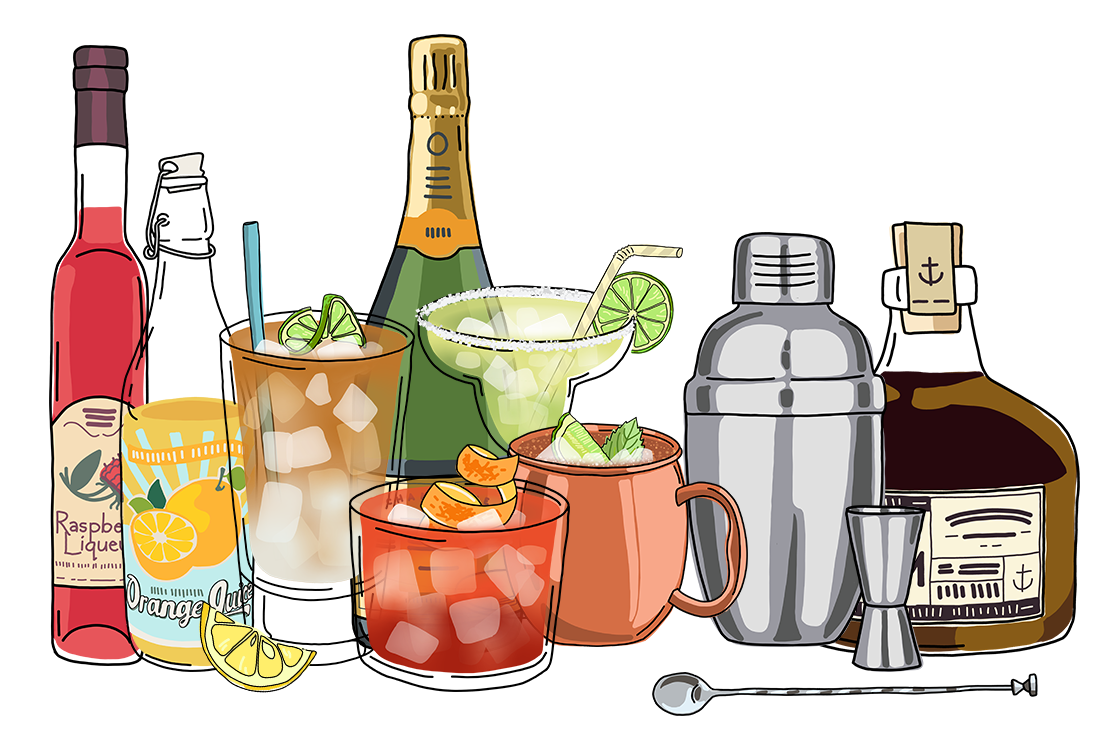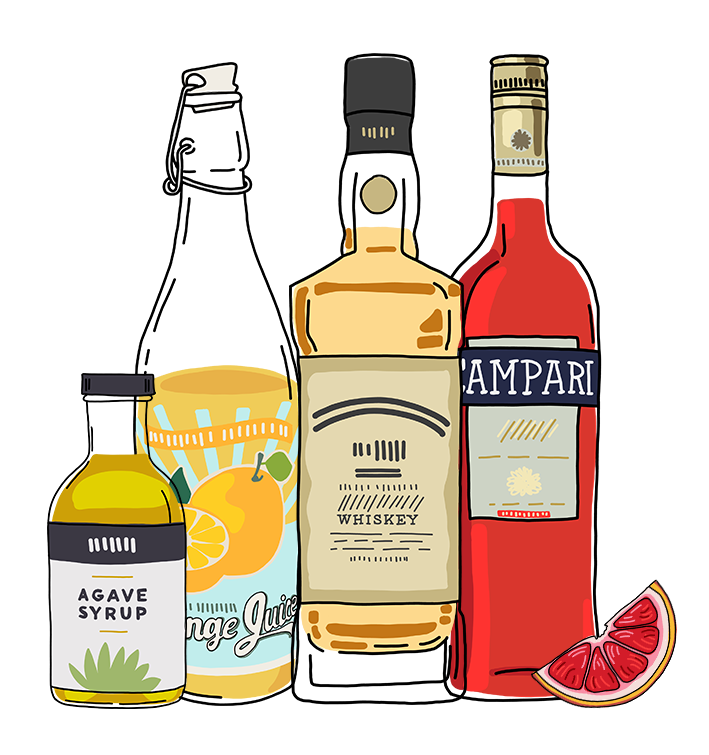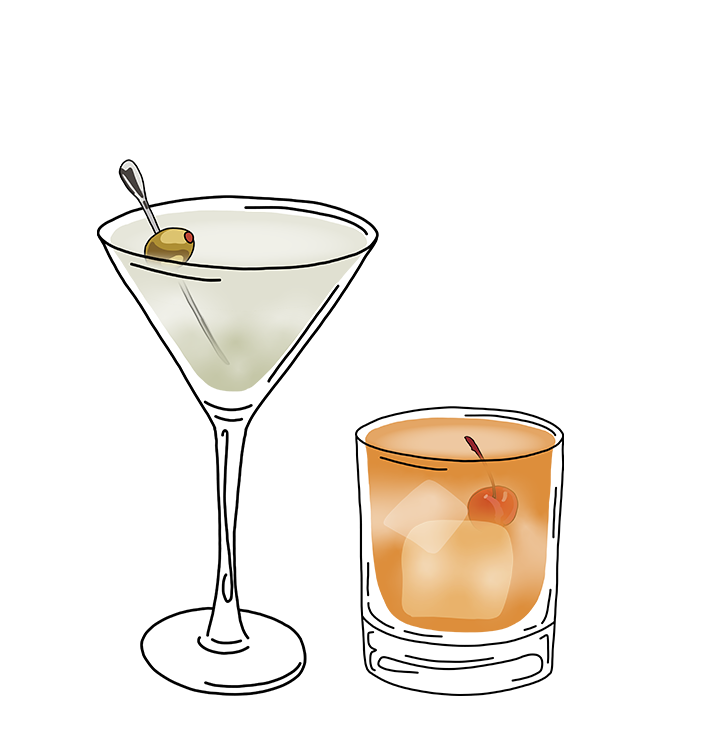Happy Hour Continues at Home
While staying home, you can carry on happy hour traditions and perfect your home bar.

The time period between when the workday has ended and before dinner starts has a bit of magic to it. They are hours that should be used to wind down with a cocktail in good company at a crowded bar or on a back deck in the summertime, rehashing the day, releasing its stress, and enjoying a brief respite.
Before-dinner drinks have a long-standing tradition reaching back to nineteenth century Paris, when the cultural elite of the Belle Époque would gather for “green hour” at local bistros, sipping absinthe and discussing the news of the day. Italians have built a similar tradition of drinks and light snacks in their aperitivo hour, which has spread from Milan south to Naples. Absinthe is swapped for amari or bitter-leaning cocktails, such as negronis, served alongside salty small plates, all designed to prime the appetite.
American happy hour is named after organized leisure time with entertainment, boxing matches and dancing on Navy ships in the early 1900s. While alcohol was banned from these ships in 1914, the gatherings continued as a time to connect and relax during wartime. Taking cue from these sailors, the American pre-dinner cocktail tradition started in earnest during Prohibition, when diners would meet before dinner to imbibe illegally, since restaurants could not provide drinks with their meal. By mid-century, that tradition evolved into a cocktail hour at the end of the workday before commuters crowded trains back to the suburbs for dinner at home.
In this time of pandemic, we have a unique opportunity to recapture cocktail hour in our homes. A home bar is as much a practice as a collection of objects. Developing technique, taste and personal style are as integral to a cocktail hour as a shaker and ice.

Ingredients
There are a few essentials to keep stocked on your bar cart and in the pantry to make a wide range of cocktails. However, your liquor cabinet should become as customized as your fridge. If you’re just starting out, focus on a few classic cocktails, their ratios, and balance of flavors.
Base Spirit: The most important part of any cocktail is the base spirit: gin, vodka, bourbon, rum, tequila or otherwise. You can start with one of each so you’re ready to make anything. But Nicholas Priedite, bartender and beverage director at The Boat House and the Lark in Santa Barbara, California, suggests, “look at what you personally like to drink first, and scale from there. You can build off that, and you can start growing your library and your collection of not only spirits, but tools to get you building a more varied selection of drinks.” Outfit yourself to build your favorite drink, or simply start with a spirit you love and experiment from there.
Bitters: Bitters can warrant a library of their own for passionate collectors, but the standard home bar setup can happily exist with one to three options: Angostura, Peychaud’s and orange. If most bartenders had to choose only one to stock, they would likely choose Angostura with its bitter, warm flavor profile. In his detail-driven guide to cocktail building, The Bar Book, Jeffery Morgenthaler calls bitters “the salt and pepper of cocktails.” A dash of bitters will deepen the flavors of a cocktail, enhance the qualities you love in a certain spirit, and create a more finished final product.
Sugar: Outside of the liquor cabinet, sugar is the most important staple for your home bar. While a basic simple syrup made with a one-to-one ratio of sugar to hot water will help build many cocktails, pulling from your pantry to play with sweeteners is an important part of growing your home practice. “Changing something as simple as sugar really makes you think, and [when you] make proper adjustments, you start to build this knowledge of how different ingredients play with each other,” says Priedite. By simply adjusting the amount and type of sweetener to pair with the same base spirit, you can transform the personality of your cocktail. Swap the simple syrup used in a traditional daiquiri for agave, but prepare to adjust the ratio of ingredients slightly because agave is dense and rich. Honey will offer not only a different level of sweetness, but a new layer of flavor.
Acid: Finally, you’ll need citrus for the acid component of many cocktails. If you can, juice fresh citrus in the moment. It takes a little more planning and a few extra seconds to prep, but the results are worth the effort. Renshaw asserts, “Citrus starts to change and oxidize the moment you juice it, so it’s important to have the freshest juice possible.”
A pro tip is to zest or peel your citrus before juicing it to get more bang for your buck. Not only will you have a great garnish for your cocktail, but you can use the rest of that zest for cooking or baking to add some acid to any dish.

Equipment
Much like a chef needs knives, there are a few basics you need to build a cocktail.
Jigger: Most bartenders will say you need a jigger to help measure components accurately and efficiently. While you can convert ounces to tablespoons or use ratios over exact measurements, for very little investment a jigger will make your life a lot easier, and it’s possibly the simplest way to make your home bar setup feel professional.
Pint glass: You can splurge on crystal, use the commemorative glass from the 5K you ran last year, or even repurpose the mixing tin from your shaker. It only matters that the glass is sturdy and big enough to hold the contents of one to two cocktails and plenty of ice.
Shaker: There are two main types of shakers. A cobbler shaker comes in three pieces: the mixing tin in which you build the drink, a lid with a strainer built in, and a small cap to cover the strainer lid while you shake. In a pinch, that cap can also become a measuring device. Alternatively, the Boston shaker consists of two mixing tins that fit together to build a vacuum seal for shaking. These can generally hold a greater volume and offer more flexibility, but require an additional piece of equipment—a Hawthorne strainer—to pour. There is no right answer to which kind of shaker to use; it’s based on your personal style and preference.
Elbow juicer: Because fresh-squeezed juice is always preferred.
Bar spoon: The key is that the spoon is long enough to hold above the rim of the glass, and thin enough to stir your cocktail correctly.

Technique
There is tension between sweetness, bitterness and acid in a good cocktail. Between the power of the base spirit and its supporting chorus of ingredients building flavor and texture around it. And even between the drink itself as it steals the chill from the ice in the glass, which dilutes it in turn. The only absolute is that a cocktail should be cold.
There are two primary categories of cocktails based on how they are chilled: shaken and stirred. Both result in properly combined ingredients, dilution to take the sting off the spirit, and make sure the drink is bracingly cold. But each technique creates a different texture and level of dilution to ensure the most pleasurable drinking experience for a specific cocktail’s personality.
Shake to Aerate, Chill and Dilute: Anything with citrus, dairy or eggs typically should be shaken since these elements are all designed to build texture, as well as flavor, in a cocktail. There are many techniques for shaking based on available tools and personal style, but it should be vigorous and last until the mixing tin frosts outside, for about ten to eighteen seconds, depending on the size of your ice and personal dilution preference. If the contents inside are tossing correctly, your ice should “clack” rather than “rattle” in the shaker. The results of shaking a cocktail are foamy, cloudy and diluted. Strong aeration builds tiny air bubbles throughout the drink.
Stir to Dilute and Chill Without Aeration: Spirit-forward drinks should appear crystal clear and smooth in the glass. Stirring your drink like cake batter will get the job done. But to do it like the pros, rotate your bar spoon gently in a circular motion around the inside edge of the glass, mixing the contents without rattling the ice cubes into each other. Stir until the tin is frosty.






Our comments section is for members only.
Join today to gain exclusive access.